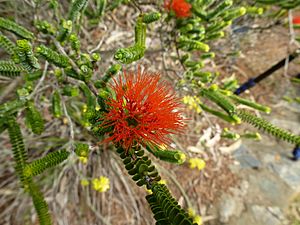Sand bottlebrush facts for kids
Quick facts for kids Sand bottlebrush |
|
|---|---|
 |
|
| Beaufortia squarrosa growing in Kings Park | |
| Scientific classification | |
| Genus: |
Beaufortia (plant)
|
| Species: |
squarrosa
|
| Synonyms | |
|
Melaleuca pulcherrima Craven & R.D.Edwards |
|
The Beaufortia squarrosa, often called the sand bottlebrush, is a cool plant from the Myrtaceae family. This is the same family that includes eucalyptus trees! It grows only in the south-west part of Western Australia, which means it's endemic there. The local Noongar people have a special name for it: buno.
This plant can be a thick bush or a more spread-out shrub. It has small, oval leaves arranged neatly in four rows along its stems. In the warmer months, you can see its bright red, orange, or yellow flowers. These flowers often look like a bottlebrush, which is how it got its common name!
Contents
What Does the Sand Bottlebrush Look Like?
The sand bottlebrush is a shrub that can grow up to about 2 metres (7 ft) tall. Its leaves are packed closely together. They are arranged in a special way: each pair of leaves grows opposite the last, but turned a quarter-turn. This makes them form four neat rows along the stems. The leaves are shaped like an egg or an oval. They are quite small, less than 4.5 millimetres (0.2 in) long, and have 5 or 7 tiny veins.
The flowers are usually a bright red color. Sometimes, you might see them in orange or yellow. They grow in round clusters at the ends of the branches. Even after the flowers bloom, the branches keep growing! Each flower has 5 sepals (small leaf-like parts under the petals) and 5 petals. The most colorful parts are the 5 bundles of stamens. Stamens are the parts of a flower that make pollen. Each bundle has 3 to 7 stamens, and they are joined together for more than half their length.
You can see these beautiful flowers from July to December, or sometimes from January to May. After the flowers, the plant grows woody capsules, which are like small, hard seed pods.
How the Sand Bottlebrush Got Its Name
The scientific name for this plant, Beaufortia squarrosa, was first officially written down in 1843. This was done by a person named Johannes Conrad Schauer. He wrote about it in a book called Dissertatio phytographica de Regelia, Beaufortia et Calothamno.
The second part of its name, squarrosa, comes from a Latin word. This word means "rough with stiff scales, bracts, leaves or processes." It probably describes how the leaves are arranged or how they feel.
Where Does the Sand Bottlebrush Grow?
The sand bottlebrush mostly grows along the coast in Western Australia. You can find it between the areas of Busselton and Eneabba. It likes to grow in sandy plains. It also grows in low areas that get wet during the winter months.
Is the Sand Bottlebrush Safe?
The government department in Western Australia that looks after parks and wildlife has checked on the sand bottlebrush. They have officially said that it is "not threatened." This means there are plenty of these plants around, and they are not in danger of disappearing.


